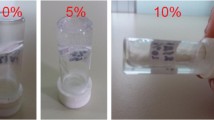Summary
A new route towards the formation of micro-phase separated semi- interpenetrating polymer networks (semi-IPN's) is described for the system atactic PS in methacrylates. It comprises the arrest of spinodal decomposition of an aPS solution by thermoreversible gelation (vitrification) of the polymer-rich phase. After lowtemperature UV-polymerization and crosslinking of the methacrylate, the phase separated structure is preserved at room temperature. Thus the steps of morphology formation and polymerization are separated.
The demixing and gelation behaviour of solutions of atactic PS in several n-alkyl and branched methacrylates was studied. Gelation temperatures were found to be determined by the position of the demixing curves along the temperature axis and thereby the intersection points with the glass transition-concentration curve of plasticized PS. At polystyrene concentrations of 2 and 5 wt% a bicontinuous microphase separated morphology could be obtained with domain sizes of 0.2–0.5 μm.
Similar content being viewed by others
References
Sperling L (1981), Interpenetrating networks and related materials, Plenum Press, New York
Donatelli A, Sperling L, Thomas D (1976) Macromolecules 9:671
Cahn J (1963) J. Chem. Phys 42(1):93
Utracki L (1990) Polymer alloys and blends, Carl Hanser Verlag, Münich
Hashimoto T, Takanaka M, Jinnai H (1989) Polymer Communications 30:177
Aubert J, Clough R, (1985) Polymer 26:2047
Rogovina L, Slominski G (1974) Russ. Chem. Rev. 43:503
Arnauts J, Berghmans H (1987) Polymer Communications 28:66
Hikmet R, Callister S, Keller A (1988) Polymer 39:1378
Lemstra P, Smith P (1980) J. Mater. Sci 15:505
Berghmans H, Donkers A, Frenay L, Stoks W, et al. (1987) Polymer 28:97
Vanderweerdt P, Berghmans H, Tervoort Y (1991) Macromolecules 24:3547
Girolamo M, Keller A, Miyasaka K et al. (1976) J. Pol. Sci. Pol. Phys. Ed 14:39.
Wellinghoff S, Shaw J, Baer E (1979) Macromolecules 12:933
Frank F, Keller A (1988) Polymer Communications 29:186
François J, Gan J, Guenet J (1986) Macromolecules 19:2755
Hildebrand J, Scott R (1950) The solubility of non-elctrolytes, 3rd edn Rheinhold Publishing Corp., New York
Van Aartsen J (1970) Eur. Pol. Jour. 6:919
Author information
Authors and Affiliations
Rights and permissions
About this article
Cite this article
de Graaf, L.A., Möller, M. Microphase separated semi-interpenetrating polymer networks from atactic polystyrene and methacrylates — a novel route. Polymer Bulletin 27, 681–688 (1992). https://doi.org/10.1007/BF00297439
Accepted:
Issue Date:
DOI: https://doi.org/10.1007/BF00297439




